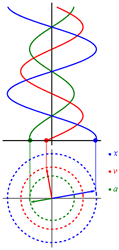 Dr. Anthony Pratt, Orbstar International Ltd.
Dr. Anthony Pratt, Orbstar International Ltd.In the beginning, there was just the Global Positioning System. But it provided an astounding start to the world of GNSS.
Since the United States declared full operational capability (FOC) for GPS in 1995, two major things have occurred:
In the beginning, there was just the Global Positioning System. But it provided an astounding start to the world of GNSS.
Since the United States declared full operational capability (FOC) for GPS in 1995, two major things have occurred:
- a phenomenal uptake of GPS technology — more than a billion receivers estimated to be in use worldwide — and
- the emergence of three other GNSS systems, two regional systems, and several space-based augmentations.
Today, we have well more than 60 operational GNSS satellites in orbit from several systems transmitting a variety of signals on multiple frequencies. Within five years, given the announced plans of GNSS system operators, the number of satellites will reach 90-plus — with even more signals and frequencies.
All of which represents good news and maybe some not-such-good news for GNSS product designers, service providers, and end users. Because even as this trend increases access to the basic GNSS resource — signals in space — and the prospect of interoperability that produces a synergistic effect from using multiple systems, it brings new challenges for the global GNSS community.
For example, recent studies have indicated that too many GNSS systems operating in the same band may create more problems by raising the RF noise floor for receivers than it solves by increasing the accuracy and availability of positioning services.
That raises fundamental questions about ensuring GNSS compatibility, which practically means the prevention of harmful interference with use of individual services or signals. In many ways, GNSS compatibility is primarily a matter of dealing with the laws of physics.
With these issues in mind, we turned to Dr. Anthony Pratt, a leading British consultant and GNSS signal expert, to explore the challenges and opportunities presented by multiple GNSSes.
Pratt is a consultant to the UK government in the development of the Galileo satellite system and a member of the European Commission Signal Task Force that developed the multiplexed binary offset carrier (MBOC) signal enshrined in the 2004 EU-US Agreement on GPS Galileo Cooperation. He currently is senior consultant with the GPS Telematics Group at QinetiQ Ltd.. and manages the navigation course at TU Delft Spacetech Master’s Program.
IGM: How do overlapping signals conflict with one another?
PRATT: Every navigation signal leaks into adjacent signals in the same band. This is an inevitable consequence of the choice of spreading symbol and transmission bandwidth of a GNSS system. We can see an example of this in the L1 band just by observing the power spectral densities (PSDs) of the actual and proposed signals from GPS, Galileo, and Compass II.
A single-sided plot [see accompanying figure] of the spectrum out to 20.46 MHz on either side of the L1 band center (1575.42 MHz) shows a very busy RF environment. We can readily observe that individual transmissions have spectra which substantially overlap one another. The more important question is to what extent is the overlap tolerable. From a technical perspective, the leakage of one signal into another can be easily determined through spectral separation coefficients (SSC) and the power levels of the individual signals upon reception in a GNSS receiver.
By appropriate computation, we can readily determine that spectra (PSDs) where the sidelobes of one fall inside the main lobe of another signal have lower SSC values, whereas signals where the mainlobes overlap generally have higher SSC values. This is the case for Galileo PRS signals, which are clearly overlapped by the main lobe of the Compass II QPSK 2 spectra, and to a lesser extent, for the influence of Compass signals on the U.S. military M-code signal.
IGM: Is such interference troublesome?
PRATT: Ostensibly, on a worldwide basis such interference is regulated by the International Telecommunication Union (ITU), which requires that users of the radionavigation satellite system (RNSS) bands, amongst others, do not cause harmful interference to one another.
The ITU concentrates on regulating the mutual interference between two parties (bilateral), but there appears to be no regulation of the overall noise (multilateral) in the L1 band resulting from the combination of all constellations (as is the case in the L5 band). Perhaps, this might be a role for the UN International Committee on GNSS (ICG).
Clearly, mutual interference causes a degradation in service levels. Some might be insignificant; in other cases, it might be significant, especially if the system performance margin is small initially. How serious this is, will depend upon the use of the system and the intended performance envelope.
IGM: How about the issue of a rise in the overall “noise floor” caused by the increasing numbers of GNSS signals operating in the same RF bands?
PRATT: We have known for some time that the combined effect of the C/A code transmissions from the GPS constellation raises the noise floor, above thermal levels, of a receiver adapted to process C/A-code signals. This is not of much concern to a receiver with a poor noise figure in which the noise from the receiver masks the constellation effects.
However, the best C/A-code receivers have their ultimate measurement accuracy limited by, inter alia, the cross-correlation noise of C/A code from satellites other than the one being measured. In reality, the effect is not serious.
In the early days of the EU/US Agreement, the effect of two constellations both transmitting the same spreading symbol (MBOC) did raise the noise level for MBOC receivers, but not by much. Since then, several additional GNSS system providers have been persuaded to adopt the same modulation format. Ultimately five satellite constellations may all be broadcasting the MBOC spectrum.
Great for signal choice! However, some of the proposals are for significantly increased power flux density than, for example, Galileo transmissions. This has the potential to significantly increase the background noise level for MBOC receivers. A combined calculation for five global GNSS constellations with reasonable assumptions suggest that the noise floor for MBOC receivers will be raised by up to five decibels above thermal levels (-204dBW/Hz).
An increase as large as 5dB is certainly of concern because this implies a background noise level of -199dBW/Hz. Good quality receivers should have better noise figures than 5dB; so, their performance will be constrained by such increases.
IGM: What does all this mean for the prospect of GNSS interoperability?
PRATT: Evidently, the EU/US negotiation focused, in part, on interoperability of the civilian signals in the L1 band. But interoperability does not have to cover every aspect of a system design. We might argue that as long as the civil signals from two different systems can be received with no significant receiver biases on a single receiver, this is a sufficient step forward. At least, having the same transmission frequency and PSD could be considered as necessary attributes.
Ideally, compatibility should extend to the use of common geodetic reference and time systems. This does not mean that the realizations of such systems need to be common however.
An alternative definition might encompass the concept of interchangeability, which suggest a wider mix of common attributes, potentially including common code families, common navigation data formats (and orbital models), and common geodetic and time reference systems and their realizations.
Use of common code families can provide a definite benefit — where other system attributes are also common. This holds the potential to reduce mutual interference levels by one decibel or more. However, agreement on this issue is hard to grasp. Unfortunately, the performance of one code family mixed with those from another is no better than if each code set were chosen from a random code without any optimization. The present situation whereby each GNSS system provider selects their own code family is the least good of all the choices from the perspective of best overall performance.




